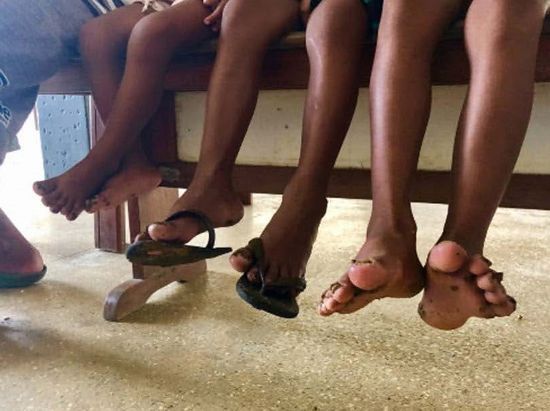
Tungiasis is one of the most neglected tropical diseases (NTDs). There is a need to reinforce skills of national and district health workers to know and identify the disease, understand the risk factors according to the context and living conditions of the affected communities, and promote the implementation of integrated interventions, including the treatment of persons and animals, to reduce the morbidity associated with tungiasis, and eliminate the occurrence of severe tungiasis cases. This course examines the epidemiology of tungiasis, clinical aspects, diagnosis, treatment and prevention, socioeconomic impact, and public health interventions.
Picture: Pan American Health Organization, Project in Alto Rionegro, Brazil. Tungiasis in humans. Tumbirá project: training activities for controlling tungiasis in indigenous communities link
Language: English
Tungiasis
Course information
This course is also available in the following languages:
português - español - français
Tungiasis has been included as part of the skin-neglected tropical diseases in the NTD road map 2021-2030 launched by WHO in 2020. Tungiasis is caused by the penetration of sand fleas into the epidermis of its host and affects mostly resource-poor urban and rural communities in Sub-Saharan Africa, South America, and the Caribbean. There is a lack of reliable data on geographic distribution, prevalence, and intensity of infection, but there have been reports of communities with prevalence up to 60% in children and 30% in the general population. In endemic areas affected, people suffer from heavy infections and severe, frequently debilitating and incapacitating morbidity.
However, national and local health authorities do not prioritize this disease within the public health intervention plans, mainly because of lack of data, knowledge or interest. Thus, affected communities still usually use treatments that cause more harm than good, although effective and safe means for prevention and treatment exist. The aim of the course is to provide information about tungiasis to increase knowledge and skills of national and health workers to address this disease. The course includes background information on skin-NTDs, epidemiology of tungiasis, pathogenesis and clinical pathology, diagnosis, treatment, and prevention, socioeconomic impact, and public health interventions.
Learning objectives:
By the end of this course, you should be able to:
- Understand the epidemiology of tungiasis;
- Describe the clinical aspects;
- Understand how the diagnosis is made;
- Explain how to treat and prevent tungiasis;
- Understand the socioeconomic impact; and
- Describe the public health interventions.
Course duration: Approximately 2 hours.
Certificate: A Record of Achievement certificate will be available to participants who score at least 80% of the total points of the final quiz. Participants who receive a Record of Achievement can also download an Open Badge for this course. Click here to learn how. .
Course contents
Module 1: Introduction:
This introductory module gives an overview of the neglected tropical diseases (NTDs), skin-NTDs, and tungiasis.Module 2: Epidemiology of tungiasis :
By the end of this module, you should be able to: explain what is the causative organism and its life cycle consisting of an on-host and an off-host part; understand the penetration and neosomy of the sand flea; differentiate the several developmental stages of the sand flea once it penetrates the skin of an individual; explain the transmission and the associated risk factors of tungiasis; describe the geographical distribution of tungiasis and its occurrence and prevalence including tungiasis in travelers; understand the seasonal variation, age and gender distribution.Module 3: Pathogenesis, clinical pathology, and diagnosis:
By the end of this module, you will be able to: explain the topographic localization of sand flea; explain the pathogenesis; understand the characteristics of the acute and chronic pathology; describe the characteristics of very severe tungiasis; use of the Fortaleza classification and the viability signs of embedded sand fleas in the skin for the diagnosis of tungiasis.Module 4: Treatment and prevention:
By the end of this module, you will be able to: describe the health hazards of traditional treatment; understand the available treatment options; and explain the available prevention measures.Module 5: Stigmatization and socioeconomic impact; Public health interventions.:
By the end of this module, you will be able to: explain the impact of tungiasis in children; understand how tungiasis causes stigmatization and physical impairment; describe the morbidity of tungiasis in domestic animals; explain how and why tungiasis is related to poverty; and explain the public health interventions to control tungiasis from the integrated perspective of One Health.
Enroll me for this course
Featured content
Certificate Requirements
- Gain a Record of Achievement by earning at least 80% of the maximum number of points from all graded assignments.
- Gain an Open Badge by completing the course.